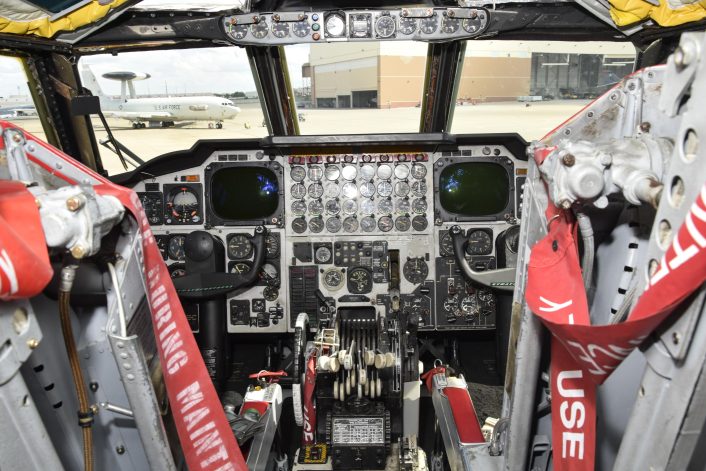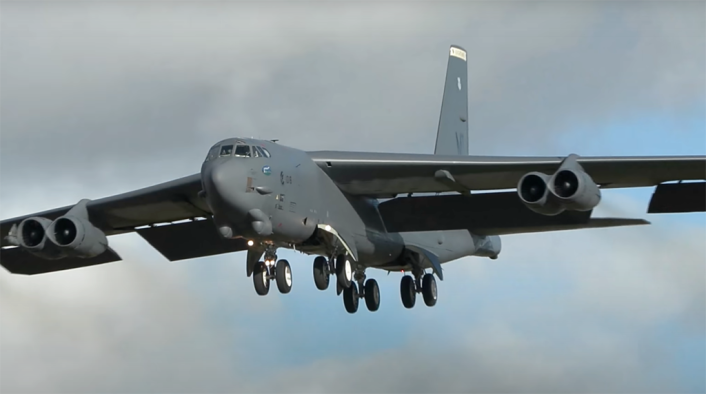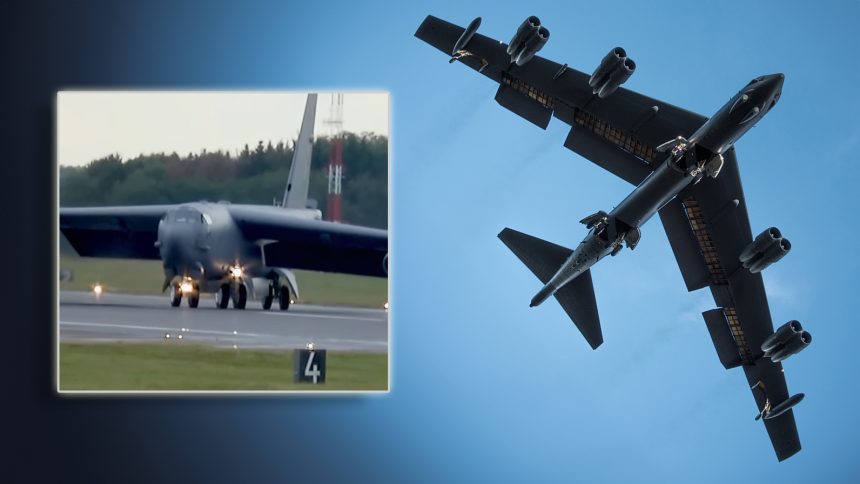The U.S. Air Force’s iconic B-52 bomber was ingeniously designed with landing gear that can be positioned up to 20 degrees left or right of the centerline for both takeoff and landing.
A crabbed landing, also known as a crab landing or crosswind landing, is a technique used by pilots to land an aircraft safely when there is a significant crosswind blowing across the runway. During a crabbed landing, the aircraft’s nose is pointed into the wind to maintain the desired ground track, while the aircraft’s longitudinal axis (the fuselage) is aligned with the runway centerline. This results in the aircraft appearing to be “crabbing” sideways as it approaches the runway.
In practical terms, during a crabbed landing approach:
- Approach Phase: The pilot flies the aircraft towards the runway with the nose pointing into the wind to counteract the crosswind’s drift. This means the aircraft is not aligned with the runway centerline but is instead pointed slightly into the wind.
- Final Approach: As the aircraft descends towards the runway, the pilot maintains this crab angle to counteract the crosswind and keep the aircraft tracking straight towards the intended touchdown point on the runway.
- Touchdown: Just before touchdown, the pilot may execute a maneuver known as “kicking out” or “de-crabbing.” This involves using rudder input to align the aircraft’s longitudinal axis (fuselage) with the runway centerline while maintaining directional control.
- Rollout: After touchdown, the pilot continues to use ailerons and rudder to keep the aircraft aligned with the runway centerline and counteract any remaining crosswind.
A crabbed landing requires skillful coordination of flight controls to ensure a safe touchdown and rollout despite challenging wind conditions.
As you may understand, the difficulty is much higher in larger aircraft. Due to its wingspan, the B-52 can’t do that. De-crabbing at the wrong moment could have catastrophic consequences.
Crabbed landing in the B-52
In the case of the B-52 bomber, a crabbed landing is executed by leveraging the unique design of its landing gear, which includes steerable bogies that can be angled up to 20 degrees left or right of the centerline.
As the B-52 approaches the runway for touchdown, the pilot can use the aircraft’s unique steerable landing gear to align the wheels with the runway centerline for a straight rollout. The pilot can simply input the runway’s heading using a rotary dial in the cockpit, and the landing gear will automatically align with the selected compass heading throughout the aircraft’s approach. This adjustment minimizes the side load on the landing gear and ensures stable ground contact.

After touchdown, the pilot continues to use the steerable landing gear, along with rudder and aileron inputs, to maintain directional control and counteract any remaining crosswind forces during the rollout phase.
Steerable landing gear
The steerable landing gear on the B-52 plays a critical role in allowing the aircraft to execute safe and effective landings in crosswind conditions. By independently adjusting the angles of the bogies, the pilot can align the aircraft with the runway centerline while compensating for the effects of crosswinds. This capability enhances the B-52’s ability to operate from a variety of airfields under diverse weather conditions, ensuring reliable and safe landings even in challenging wind environments.
According to NASA, which has operated the B-52 (referred to as “BUFF” – Big Ugly Fat Fellow), “the landing gear of the B-52 is of the same bicycle arrangement as employed on the B-47 but has four two-wheel bogies instead of the two bogies used on the earlier aircraft. As compared with their location on the B-47, the outrigger wheels are positioned much nearer the wingtip on the B-52. An interesting feature of the B-52 landing gear greatly eases the problems posed by crosswind landings. Both the front and rear bogies can be set at angles of as much as 20° to either side of the straight-ahead position. In a crosswind landing, consequently, the aircraft can be headed directly into the wind while rolling down a runway not aligned with the wind.”

The primary reason for this unique design feature is the B-52’s airframe structure, characterized by a very long and relatively slender fuselage, large tail, and massive high wings that bear the weight of the aircraft. Due to this configuration, the B-52 is slow to respond to pilot inputs on flight control surfaces, particularly at low altitudes and speeds. Additionally, the expansive wingspan of the B-52 makes the conventional crosswind approach, which involves applying a Wind Correction Angle (WCA) to “crab” the aircraft to align its nose and tail with the wind direction to counteract side winds, impractical during landing.
This demonstrates the impressive capability of the B-52 to maintain a crabbed approach right up to touchdown without the need to align with the runway centerline beforehand. The aircraft can touch down with its main landing gear still in a rotated position, allowing it to land at an angle to compensate for crosswinds. Notice the angle of the wheels during the second landing, as well as the fuselage’s angle relative to the runway centerline. This ability showcases the B-52’s versatility and effectiveness in handling challenging crosswind conditions during landing.
Using the swiveling landing gear to land in a storm
Two rare red warnings were issued for storm Eunice 2022, the most severe and damaging storm to affect England and Wales for many years. Winds gusted at over 70Kt (81mph) in exposed coastal locations and a gust of 106Kt (122mph) was recorded at Needles Old Battery, Isle of Wight, setting a new England gust speed record. Winds gusted widely at over 60Kt (69mph) across southern England.
The UK Met Office increased the severity of its “danger-to-life” weather warning ahead of Storm Eunice, which wreaked havoc by tearing down rooftops, uprooting trees, damaging cars, and severely disrupting air travel with numerous flight cancellations.
In spite of the hurricane-strength winds, two B-52 Stratofortress bombers deployed to RAF Fairford, UK, as part of Bomber Task Force 22-2, successfully completed a round-trip mission over Scandinavia.
Flying under radio call signs ZEUS 51 and ZEUS 52, the two BUFFs managed to land safely at RAF Fairford also thanks to the swiveling landing gear.
The video below shows the second B-52 use the steerable dual-bicycle landing gear to “crab” the airframe and keep the landing gear aligned with the runway until touchdown.
Crabwalk
On Jul. 16, 2023, during RIAT 2023 at RAF Fairford, U.S. Air Force B-52H Stratofortress bomber 61-0029/BD belonging to the 307th Bomb Wing/93rd Bomb Squadron, after landing, the BUFF taxied down the runway askew to face the strong crosswinds at RAF Fairford.
As we reported back then, during the “crabwalk”, the outrigger wheel of the Stratofortress aircraft hit and destroyed/damaged 18 runway lights.









